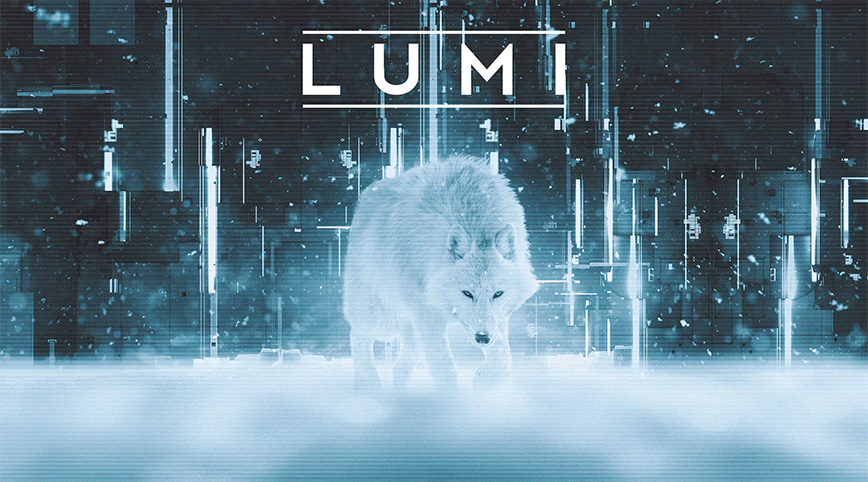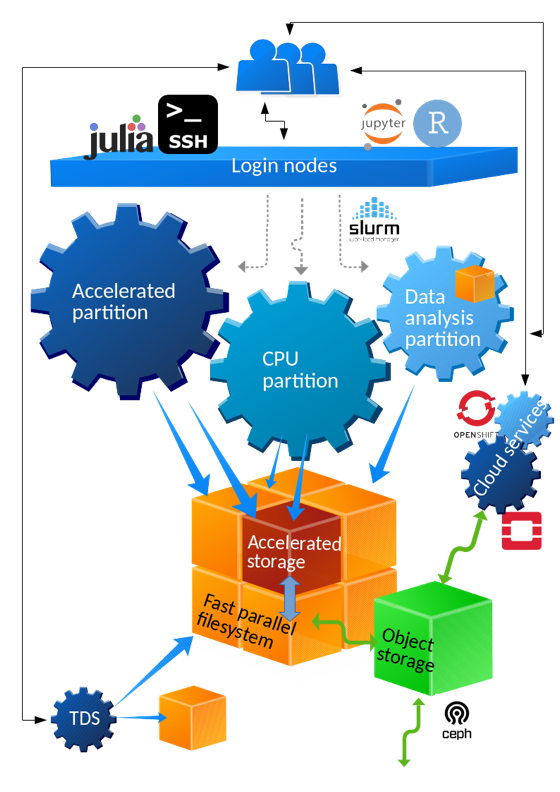Sweden, Get Ready for LUMI!
Anni Jakobsson & Pekka Manninen, CSC - IT Center for Science

The European High-Performance Computing Joint Undertaking (EuroHPC JU) is pooling European resources to develop top-of-the- range exascale supercomputers for processing big data. One of the pan-European pre-exascale supercomputers will be located at the data centre belonging to the Finnish IT Center for Science (CSC) in Kajaani, Finland. This new system is called LUMI, which comes from Large Unified Modern Infrastructure.
The new supercomputer will be hosted by the LUMI Consortium, which consists of nine countries: Finland, Belgium, the Czech Republic, Denmark, Estonia, Norway, Poland, Sweden and Switzerland. The plan is for the LUMI system to be in operation by early 2021.
Preparations at CSC’s data centre in Kajaani are in full swing as 2021 will be here in no time. Researchers using computational methods should also start thinking about how to best exploit LUMI’s capabilities. However, to do that, you will need to know what kind of supercomputer will LUMI be. Let’s go through some of the details of LUMI’s architecture.
LUMI: One of the Most Competitive Systems in the World
When LUMI goes into operation at the beginning of 2021, it will be one of the most competitive supercomputers in the world. The design philosophy for LUMI was to create a platform that would make it possible to use Artificial Intelligence (AI) techniques (especially deep learning) and traditional large-scale simulations combined with high-performance data analytics to solve a single research problem.
The theoretical peak performance of LUMI will be over 200 petaflops (2×1017 floating point operations per second) – that will make the new system approximately ten times faster than the Piz Daint supercomputer, which is the fastest in Europe at the moment. The performance of the applications on LUMI will likewise be faster than those on Piz Daint by a factor of about 10. LUMI will achieve such a high level of performance thanks to having a large number of nodes with accelerators (otherwise known as Graphics Processing Units or GPUs).
In addition to the GPUs, LUMI will have a number of supporting compute and storage resources, which will maximize the overall value: the system will be complemented by a partition consisting only of Central Processing Units (CPUs), Infrastructure as a service (IaaS) cloud services and a storage solution for large objects.
LUMI will have a highly capable parallel file system: it will consist of over 60 petabytes of storage with a sizeable flash layer for input/output (I/O). The flash layer is expected to have a volume of around 5 PB and will provide a bandwidth of more than 1 terabyte/s and an extreme input/output capability per second. The object storage, which is anticipated to be 30 PB in size, will be there to facilitate convenient management of data.

LUMI: A Leadership-Class AI Platform
LUMI’s massive computational capability, which is based on GPUs and extreme connectivity between nodes, makes LUMI a leadership- class platform for AI-based research. The I/O capabilities of LUMI make it possible to use, and perform computations on, big datasets. As LUMI will have both GPU and CPU processors, it will be possible to mix CPUs and GPUs in the same work flow, even for the same application, thus making it possible to combine AI methods and simulations.
Easy-to-Use, Rich Stack of Pre-Installed Software for Research
Now that you understand the overall architecture of LUMI, we will look at the software that is likely to be available on LUMI.
In addition to offering traditional command-line interfaces, the intention is that LUMI will support high-level interfaces. Applications such as Jupyter Notebooks, RStudio and Matlab will be seamlessly integrated into the back-end of LUMI, so that ultimately LUMI will be an extension to researchers’ laptops. LUMI will have a rich stack of pre-installed software, which will include code developed by research communities and also commercial applications. Furthermore, LUMI will feature a collection of reference datasets that will be readily available and curated (Datasets as a Service). The system will also provide capabilities for the interactive visualization of results during the execution of simulations.
The plan is that LUMI will be in operation next year, that is, early in 2021. Research communities should, therefore, start thinking now about how to utilize the significant increase in computing capacity that LUMI will provide, and should start to prepare software for LUMI's architecture. Software that currently uses only conventional processors can be modernized to employ GPUs, or alternatively, research groups may prefer to start using software that already makes use of GPUs with similar functionality.
Eco-Friendly Data Centre
Reducing CO2 emissions is a globally critical goal, and the location of the EuroHPC machines has a huge impact on that, as supercomputers consume plenty of electricity. Supercomputers of LUMI’s size would generate 50,000 tons of CO2 emissions annually if they were powered by fossil-fuel-based electricity. However, the CSC data centre in Kajaani uses renewable and CO2-neutral electricity.
Furthermore, LUMI will use warm-water cooling, which enables its waste heat to be utilized in the district heating network of Kajaani, and thus can replace heat that would otherwise be produced by fossil fuels. The amount of waste heat from LUMI that will be used in Kajaani's district heating network will be equivalent to up to 20 percent of Kajaani's energy needs in terms of the area's district heating. The reuse of this waste heat will reduce the annual CO2 footprint of Kajaani by 13,500 tons: an amount equivalent to that of 4,000 passenger cars!
An interesting point to note about the name LUMI is that, although it is the acronym for “Large Unified Modern Infrastructure”, as a literal word, “lumi” means snow in Finnish. So “snow” will be heating Kajaani from next year onwards.
Who Can Access LUMI?
Now you may be wondering who will be eligible to use LUMI and how researchers can apply for time on the system.
Half of the LUMI resources belong to the EuroHPC Joint Undertaking, and the other half of the resources belong to the participating countries, that is, the LUMI Consortium countries. Each consortium country will be given access to a share of the resources with the size of the share being based on that country’s contribution to the LUMI funding. For Sweden, the share will be 4% of the LUMI resources annually. The shares of each of the countries will be allocated according to local considerations and policies within each country – so LUMI’s resources will be seen and handled as extensions to national supercomputing resources.
The share of the LUMI resources belonging to the EuroHPC JU will be allocated by a peer-review process (comparable with applications for PRACE Tier-0 access). In particular, up to 20% of the EuroHPC JU resources will be available to researchers in the industrial sector, from both large companies and small to medium-sized enterprises (SMEs).
So, what does this mean for a Swedish researcher? A researcher affiliated with either a Swedish research institute or a company that has its headquarters in Sweden will be able to apply for LUMI resources via Sweden’s national share and, in addition, via EuroHPC’s peer-review process. The means that Swedish-based researchers have access to 4% of the total LUMI resources and can additionally apply for the EuroHPC resources via a technical and scientific peer-review process.
By partnering with European research groups and/or companies, the EuroHPC share of the LUMI resources will be available to non-European researchers as well. Note that the principal investigator (PI) for any project applying to use LUMI will need to be based in the EU or an associated country.
The peer-review and application processes for LUMI are still being negotiated so further details will be announced later nearer the inauguration of LUMI.
Note that the resources of LUMI will be allocated for the projects in terms of three different pools: GPU-hours, CPU-hours, and storage-hours. All users of the system will have access to the whole system as per batch job policies; in other words, none of the hardware will be dedicated or reserved specifically for any of the partners.
What Will Be Solved with LUMI?
The creativity of the research communities in the coming years will determine the kinds of problems that will be solved with LUMI. We foresee that, for example, LUMI will help remarkably in the following kinds of research areas.
- More precise climate models and the interconnection of different existing climate models: How will living conditions change as the climate is warming?
-
The sequencing and analyzing of full genomes, combined with data analysis and correlations to clinical data, will shed more light on diseases and particularly hereditary diseases, thus helping to identify causes of illness and determine personalized treatment and medicine.
-
Artificial intelligence (deep learning): analyzing large data sets (either from simulations or measurements) and re-analyzing such data, for example, in atmospheric science, environmental science, climate modelling, materials science and linguistics
-
Self-driving cars and vessels: the study and development of algorithms related to these modes of transport taking advantage of LUMI’s previously unprecedented computing power to make this type of transport feasible
-
Social sciences: large-scale data set analytics from social networks and the modelling of different phenomena
What are you going to discover with LUMI? To get ready for LUMI, you are welcome to subscribe to the LUMI newsletter and follow the latest news about LUMI at www.lumi-supercomputer.eu , or you can follow LUMI on social media:
- Twitter: @LUMIhpc
- LinkedIn: LUMI supercomputer
- YouTube: www.youtube.com/channel/UCb31KOJ6Wqu0sRpIRi_k8Mw
- #lumisupercomputer #lumieurohpc
